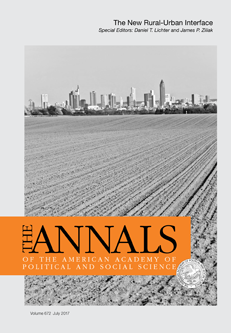For decades, rural and small-town America has been left at the sidelines of academic analysis and evidence-based policy discussions. Big city issues and interests have defined America’s most pressing social problems, but the election of Donald Trump to the presidency has been characterized as rural America reasserting itself with a vengeance.
The rural-urban divide seemingly has never been greater, but sound science tells us that the rural-urban interface—where capital, labor, people, information, and material goods flow back and forth between rural and urban America—is increasingly difficult to describe and define. A binary view of urban versus rural America is an impediment to addressing economic underdevelopment and the shared political and social interests of the nation. Rural and urban interests are interdependent, so this volume of The ANNALS provides evidence on the rural-urban interface as it is manifest today. Research here reveals what empirical science can tell us about the geographic, political, and social dimensions of the rural-urban interface today.

